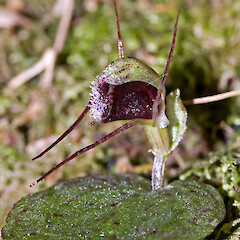Corybas oblongus
Common name
spider orchid
Synonyms
Corysanthes oblonga (Hook.f.) Hook.f., Nematoceras oblongum Hook.f. Singularybas oblongus (Hook.f.) Molloy, D.L.Jones et M.A.Clem.
Family
Orchidaceae
Flora category
Vascular – Native
Endemic taxon
Yes
Endemic genus
Yes
Endemic family
No
Structural class
Orchids
NVS code
The National Vegetation Survey (NVS) Databank is a physical archive and electronic databank containing records of over 94,000 vegetation survey plots - including data from over 19,000 permanent plots. NVS maintains a standard set of species code abbreviations that correspond to standard scientific plant names from the Ngä Tipu o Aotearoa - New Zealand Plants database.
SINOBL
Chromosome number
2n = c.34, 34
Current conservation status
The conservation status of all known New Zealand vascular plant taxa at the rank of species and below were reassessed in 2017 using the New Zealand Threat Classification System (NZTCS) – more information about this can be found on the NZTCS website. This report includes a statistical summary and brief notes on changes since 2012 and replaces all previous NZTCS lists for vascular plants.
Please note, threat classifications are often suggested by authors when publications fall between NZTCS assessment periods – an interim threat classification status has not been assessed by the NZTCS panel.
- Conservation status of New Zealand indigenous vascular plants, 2017 . 2018. Peter J. de Lange, Jeremy R. Rolfe, John W. Barkla, Shannel P. Courtney, Paul D. Champion, Leon R. Perrie, Sarah M. Beadel, Kerry A. Ford, Ilse Breitwieser, Ines Schönberger, Rowan Hindmarsh-Walls, Peter B. Heenan and Kate Ladley. Department of Conservation. Source: NZTCS and licensed by DOC for reuse under the Creative Commons Attribution 4.0 International licence.
2017 | Not Threatened
Previous conservation statuses
2012 | Not Threatened
2009 | Not Threatened
2004 | Not Threatened
Distribution
Endemic. New Zealand: North Island, South Island, Stewart Island/Rakiura, Chatham Islands, Auckland Islands, Campbell Island/Motu Ihupuku.
Habitat
Coastal to subalpine (up to 1200 m a.s.l.). Widespread on consolidated sand within shrubland and sand dune forests, in shrubland, tall forest, lowland peat bogs and subalpine mires and in cloud forest. Often found on mossy banks within dense forest, or on the margins of slow flowing forest streams.
Detailed description
Terrestrial, tuberous, winter-spring flowering, glabrous perennial herb. Plant at flowering 20–30 mm tall, usually much taller in fruit. Stem erect, purple-red, maroon or pale whitish. Leaf usually solitary, rarely paired, sessile, rather membranous, 10–40 mm long, upper surface dark green, green with red flecks, or green with red veins, undersides silvery-red or silvery-white, ovate-oblong, apex apiculate, base cordate or rounded, margins undulose or plane, entire. Floral bract prominent, foliaceous, equal in length to ovary, broadly ovate to elliptic, hyaline, pale green or pale yellow, usually flecked with red, purple or maroon. Flowers 1–(2). Dorsal sepal slightly longer than labellum, somewhat fleshy, broadly spathulate, apex broadly obtuse to apiculate, hyaline, whitish flecked with purple or red to greenish-white (rarely completely white) with red flecks; lateral sepals white to slightly off-white or completely beetroot purple, hyaline, very long, filiform. Petals similar to lateral sepals but slightly shorter. Labellum horizontal, or slightly tilted upwards, 5–10 mm long, dark crimson, to crimson-purple (almost black) or rarely completely white, base auriculate, otherwise curved to form a cylinder with a wide flaring, fimbriate mouth (fringed with numerous coarse hyaline teeth); internally with numerous retrorse hair like cilia present from near the mid-line back. Fruit a broadly cylindrical to ovoid-ellipsoid capsule, borne on a peduncle which usually elongates greatly at fruiting.
Manaaki Whenua Online Interactive Key
Similar taxa
None when flowering. The dark crimson coloured frimbriate labellum (with its conspicuous fringe of hyaline teeth) is extremely distinctive. Only Corybas cryptanthus has a similar fimbriate flower but that saprophytic species lacks leaves (and chlorophyll), is rhizomatous, and its flowers are usually hyaline with purple or red flecks or more rarely completely colourless. The sessile usually dark green red flecked or red veined leaves with their usually undulose margins are also rather diagnostic.
Flowering
September–February
Flower colours
Violet/Purple, White
Fruiting
November–April
Propagation technique
Difficult—should not be moved from the wild.
Etymology
corybas: Helmet flower
oblongus: Oblong
Taxonomic notes
Segregate genera that were split from Corybas R.Br. by Jones et al. (2002) were not universally accepted and further research has been carried out into the genus. On advice from Australian Orchidologists Peter Weston and Stephen Hopper (pers. comm., July 2011, November 2014), NZPCN has returned all of the segregate genera recognised for New Zealand by Jones et al. (2002) to Corybas (see also Lyon 2014).
Lehnebach (2016) made three combinations for those Nematoceras lacking valid names in Corybas. This action now enables the full transfer of Nematoceras back to Corybas. However, as of writing, a formal publication rejecting the segregation of Corybas by Jones et al. (2002) has yet to be published. Lehnebach cites an unpublished PhD (Lyon 2014) that indicates this move is imminent.
Attribution
Fact Sheet prepared for NZPCN by P.J. de Lange (1 January 2005). Description adapted from Moore and Edgar (1970).
References and further reading
Jones DL, Clements MA, Sharma IK, Mackenzie AM, Molloy BPJ. 2002. Nomenclatural notes arising from studies into the Tribe Diurideae (Orchidaceae). The Orchadian 13(10): 437–468. https://www.biodiversitylibrary.org/item/310769#page/2/mode/1up.
Moore LB, Edgar E. 1970. Flora of New Zealand, Volume II. Indigenous Tracheophyta: Monocotyledones except Gramineae. Government Printer, Wellington, NZ. 354 p.
NZPCN Fact Sheet citation
Please cite as: de Lange, P.J. (Year at time of access): Corybas oblongus Fact Sheet (content continuously updated). New Zealand Plant Conservation Network. https://www.nzpcn.org.nz/flora/species/corybas-oblongus/ (Date website was queried)
























